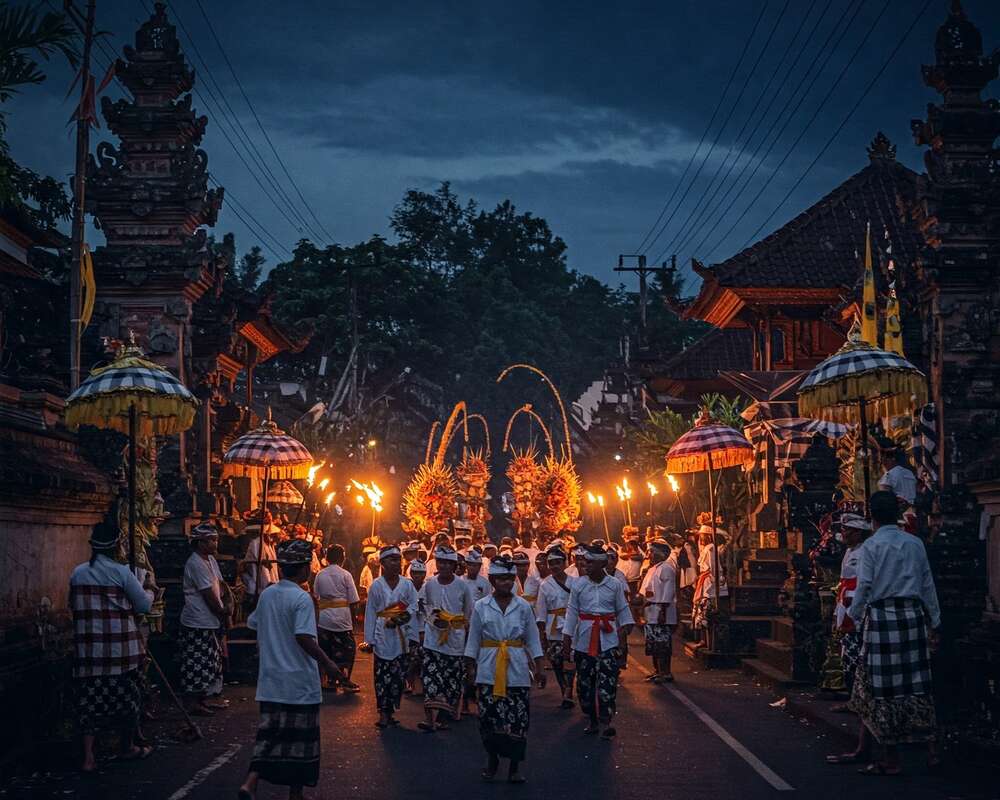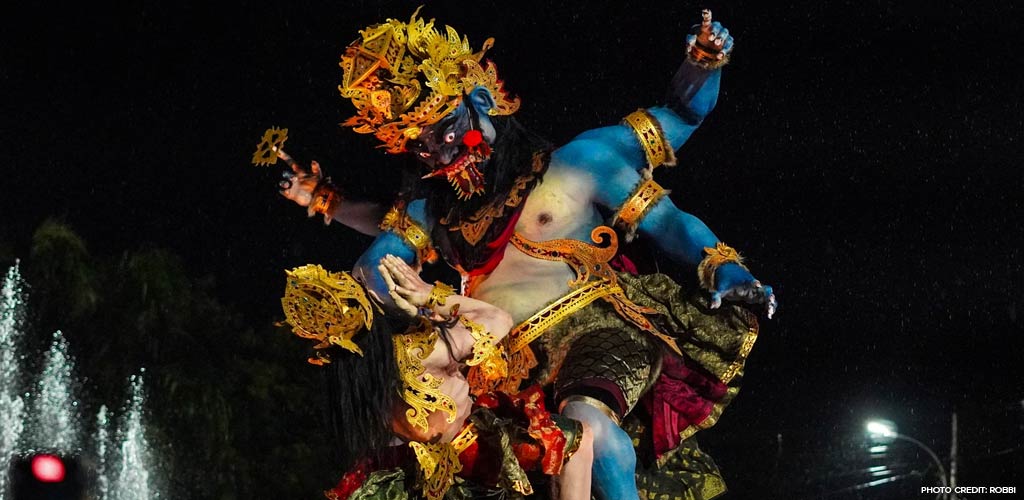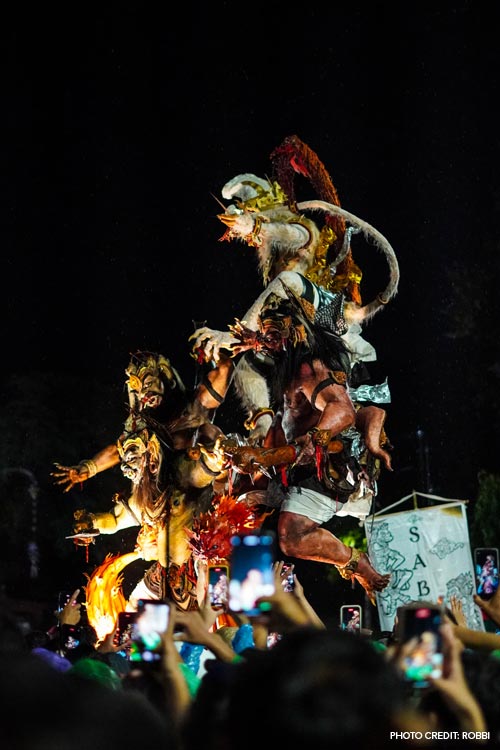
Nyepi — the ‘Day of Silence’, is how the Balinese population rings in the new year. No, it doesn’t fall on January 1, but sometime in March-April, based on the lunar Hindu Saka calendar. Strictly speaking, the celebrations span just shy of a week, marked by an increasing crescendo of activities and then the beat drops on Nyepi. But instead of a low hum, there’s pindrop silence — the Island of the Gods comes to a standstill, quite 🤐.
This silence may surprise Bali first-timers, and even repeat visitors who haven’t experienced the festival. As compared to New Year’s Eve celebrations across the world, there’s no fireworks, no partying and no revelry on Nyepi – but there’s a truck-load of it the night before! So how does the Indonesian region of Bali traditionally ring in its new year? Let’s read on below.
Occurring three days before Nyepi, Melasti is a day of traditional prep, excitement and joy. The ceremony is carried out in temple premises, especially those close to the shores. Elegantly-dressed locals, villagers and tourists alike throng the popular temples like Tanah Lot, Pura Luhur and Pura Petitenget — famous for their Melasti rituals. A train of traditionally-attired men and women reach the shores to collect holy water, which is then used to purify various sacred temple objects like the Arcca, Pratima and Pralingga. These artifacts are then taken around the villages to purify the environs. This ceremony is dedicated to Sanghyang Widhi Wasa, the Indonesian version of the God Almighty. In East Java’s Balekambang Beach, Balinese Hindu organise and perform the the Jalanidhi Puja – the water purification ritual – praying to the Hyang Baruna, the ruler of the sea.
Pengerupukan, also called ‘Tawur Kesanga’, falls the day before Nyepi. While the day is usually marked as Pengerupukan, there are various activities that occur throughout the day. Guests holidaying at one of the countryside resorts like Emana Akatara Ubud and Kayu Lama might witness a ceremonial sacrificial ritual on crossroads and intersections, places where Bhuta Kala – the Balinese deity of chaos and destruction – resides. Observant travellers (and fans of the Supernatural series) may note how this is somewhat similar to the Western lore of crossroads being the Devil’s haunt. It just goes on to show how cultures may appear wildly different… and yet have startling similarities.
Travellers may also witness the Pengerupukan ceremony at the domestic level during a village visit. The ritual is carried out post the village level ceremonies and uses a bamboo instrument called ‘kentungan’ , a fire-torch, clanging pots and pans to force evil spirits out of the house (if any, that is).

While the daytime ceremonies are significant, it is the nighttime festivities that take tourists’ breath away! As the sun sets, the streets start turning vibrant with enthused locals and colourful Ogoh-Ogoh statues. Made of bamboo, papier mache and cloth; these hugely artistic statues represent the various negative energies and forces on the island. Ergo, the devilish smiles and horrific expressions portrayed onto the demons’ visages. The Ogoh-Ogoh parade takes off amid much fanfare and travellers can catch youths surrounding their Ogoh-Ogoh and dancing, symbolizing the expulsion of negativity. As the parade progresses, turning streets and avenues into lively centres; there’s bright fireworks, music and much dance on temporary stages amidst strobing lights. Kuta, Seminyak, Nusa Dua and Sanur have some of the best Ogoh-Ogoh processions in Bali.
Thankfully, Bali Holiday Deals has tie-ups with key resorts in these areas. If you need a crash pad, check out our Bali Holiday Deals – you’ll find the freshest holiday packages with seasonal bonuses like discounted flights, free breakfast, spa vouchers, stay/pay offers, day-tours, champagne and canape afternoons, complimentary WiFi, and more!
The procession usually heads to an empty field on the outskirts of the city/village or on one of the beaches where the Ogoh-Ogoh are pooled together and then — set afire! This is the Ngerupuk ceremony and the fire consuming the Ogoh-Ogoh is considered a symbol of cleansing sacred energy. The tropical eventide celebrations mark the victory of good over evil, restoring the balance and harmony between Bhuana Agung (Universe) and Bhuana Alit (Human). Ngerupuk is symbolic of a community coming together and vanquishing the forces of evil.
There’s an important point of clarification here -the Pengerupukan may start sounding like the Rio Carnival, but it couldn’t be more apart. There’s colourful effigies in place of floats, locals and villagers dressed to the nines, music, dance and fireworks – but that’s where this Balinese festival takes a left turn. It’s an important and intrinsic part of the festival, but leads up to something completely different.

A far cry from the wild and vivid night before, Nyepi is a day characterized by zen. Starting at six in the morning, the Island of the Gods comes to a stand still and it stays that way until six am the following day. These 24 hours are periods of silence — Yoga Brata. People voluntarily turn off electricity, stay indoors, often fast and spend the day introspecting. Nyepi is what routinely shocks and awes travellers on a Bali holiday. And why not? This is a one-of-a-kind New Year’s Day celebration where an entire island falls quiet!
This day of silence is an extremely important event for the Hindus, who constitute nearly 87% of Bali’s population, and non-Hindus and travellers alike are expected to follow the rules. On this day, (March 29, 2025 this year), four main restrictions are observed : Amati Geni (no fires or electricity), Amati Karya (no physical work), Amati Lelungalan (staying in the house) and Amati Lelanguan (no entertainment and indulgence). In some areas, the internet and cellular network stop functioning. Plus, there is a strict curfew on movement, with the pecalang (traditional outdoor security men) patrolling the streets to ensure the prohibitions are carried out in letter and spirit.
This sudden no-contact policy can often flummox the uninformed holidaymaker. While it is true that no commercial establishments are open and no tours operate, as a backpacker or family on a Bali getaway there’s still much one can do. Most hotels and resorts will have their WiFi and cable network up and running and families can gather around the tv for a day of ‘staycation in Bali’. Just be sure to stock up on snacks.
Because of the restriction on electronics, and even lights, the entire region turns to almost inky blackness come nightfall. The hospitals, police, emergency responders do have lights and vehicles running, though. Hotels and resorts will request guests to keep lighting to a minimum out of respect. But, instead of a restriction, intrepid travellers will see this as an opportunity to stargaze in a near-dark zone.
Meanwhile, backpackers and couples may find this a welcome opportunity to take a pause from society, sample digital detox and spend the day unwinding with a swim, meals together and letting their thoughts wander. There’s no striving for mindfulness, it’s the Balinese day of silence and zen is in the air.
As tourists, all you are requested to do is maintain decorum and follow the above four rules for the day.
Ngembak Geni marks the end of Nyepi, with the Balinese society returning to normalcy. The day is marked by celebrations and feasts, though a little more… respectful. Friends and relatives meet each other and ritually ask for forgiveness for any transgressions, unintended or otherwise. Then, they perform the Ngembak Agni and Dharma Shanti rituals together, praying for better days ahead. Tourists rejoice, but usually for a different reason — they get to leave the confines of their hotel rooms behind and step out to participate in the merriment and ring in a new year — Balinese style!
First-timers and veteran travellers to Bali’s sun-soaked shores may find Nyepi a tad unsettling, if experiencing it for the first time. Thankfully, these 24 hours are navigable with an open mind and a healthy dose of common sense. For starters, stay indoors. Leaving your accommodation is not permitted, and frowned upon. Instead, use the time to catch up on a book, or binge Netflix with headphones. Speaking of volume, the second piece of advice: keep sound and lighting to a bare minimum, so as to not disturb others. Thirdly, no work-related activity is allowed for the locals, so no spa sessions, cooking classes, making Canang Sari offerings, hitting the bars or such. And finally, remember to stock up on snacks and self-prep meals like cuppa noodles and hot-water meal packs along with plenty of drinking water.
Also, your near and dear ones might worry if you drop off the face of the earth one fine day in Bali. Just call and let them know beforehand all that Nyepi entails (share this blog maybe?), and that you will be incommunicado for a day. After all, you want to give your loved ones Balinese keepsakes…not anxiety!
Although a Hindu New Year celebration, Nyepi is starkly different from Hindu new years’ celebrations in India like Poila Boisakh, Gudi Padwa and Ugadi. In our books, the Balinese New Year is a much underappreciated phenomenon — a study in magical realism and one that you’ll have to experience to believe. And while this cultural experience can cause just the teeniest bit of unintended stress, our all-inclusive Bali holiday packages won’t. Speak with our travel executives to book your Nyepi experience — call 1300 991 751!
Scan QR image with Google Lens

Or fill your email address below